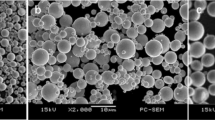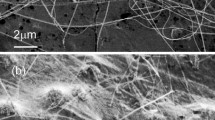Abstract
Tin pest is the product of the β → α allotropic transition at 13.2°C in pure tin. It is a brittle crumbly material, often responsible for the total disintegration of the sample. The transformation involves nucleation and growth, with an incubation period requiring months or years for completion. Experimental observations reveal a substantial inconsistency and an incomplete understanding of the process. Some alloy additions promote tin pest by reducing the incubation time, whereas others retard or inhibit its formation. Traditional solder alloys have generally been immune to tin pest in service due to the presence of lead, and bismuth and antimony as common impurities. However, the new generation of lead-free solders are more dilute—closely resembling tin. A much debated question is the susceptibility of these alloys to tin pest. Bulk samples of tin-0.5 copper solder undergo the transition at −18°C although not at −40°C after five years exposure. Other lead-free alloys (Sn–3.5Ag, Sn–3.8Cu–0.7Cu and Sn–Zn–Bi) are immune from tin pest after a similar period. Large scale model joints exhibit tin pest but it appears that actual joints may be resistant due to the limited free solder surface available and the constraint of intermetallic compounds and components. It seems likely that impurities are essential protection against tin pest, but for long term applications there is no certainty that tin pest and joint deterioration will never occur.










Similar content being viewed by others
References
‘Engineering the Future’, Open University Course, T173, Block 3, Part 5, ‘Lead-free solders’, (2001)
W.J. Plumbridge, R.J. Matela, A. Westwater, Structural Integrity and Reliability in the Electronics – Enhancing Performance in a Lead-Free Environment (Kluwer, Dordrecht, Boston, London, 2003) Chapter 1
M.R. Harrison, J.H. Vincent, H.A.H. Steen, Solder. Surf. M. Technol. 13, 21 (2001)
B. Richards, C.L. Levogner, C.P. Hunt, K. Nimmo, S. Peters, P. Cusack, Lead-Free Soldering – An Analysis of the Current Status of Lead-Free Soldering (Dept. Trade and Ind.,1999)
W.J. Plumbridge, C.R. Gagg, J. Mater. Sci.- Mater El. 10, 461 (1999)
W.J. Plumbridge, C.R. Gagg, S. Peters, J. Electron. Mater. 30, 1178 (2001)
‘The Properties Of Tin’, (Tin Research Inst., Publication 218, 1954)
W.G. Burgers, L.J. Groen, Faraday Soc. Discussions 23, 183 (1957)
O.L. Erdmann, J. Prakt. Chem. 52, 428 (1851)
G.V. Raynor, R.W. Smith, Proc. Roy. Soc. 244A, 101 (1958)
F. Vnuk, Metal Congress 45, 175 (1975)
G. Tammann, K.L. Dreyer, Z. Anorg. Chem. 199, 97 (1931)
E.S. Hedges, Tin and its Alloys (Edward Arnold Ltd, London, 1960)
R.M. Macintosh, Tin Uses 6, 72 (1966)
J.L. Gissy, J.G. Kuva, Battelle Memorial Inst. Columbus Ohio Report (1960)
E. Cohen, A.K.W.A. van Lieshout, Proc. K. Akad. Wet., Amsterdam 39, 1174 (1936)
Y.J. Joo, T. Takemoto, Mater. Lett. 3678, 793 (2002)
A.A. Matvienko, A.A. Sidelnikov, J. Alloys Comp. 252, 172 (1997)
D.R.G. Mitchell, S.E. Donnelly, Philos Mag. A 63, 747 (1991)
K. Ojima, A. Takasaki (1993). Philos Mag. Lett. A 68, 237
N. Blake, R.W. Smith, J. Mater. Sci. Lett. 5, 103 (1986)
M. Kaya, F. Vnuk, R.W. Smith, Proc. Conf. on Phase Transformations, (Cambridge, Inst. of Metals, 1988), p. 647
F. Vnuk, A. De Monte, R.W. Smith, J. Appl. Phys. 55, 4171 (1984)
E. Cohen, W.A.T. Cohen de Meester, J. Landsman, Proc. K. Akad. Wet., Amsterdam 40, 746 (1937)
E. Cohen, A.K.W.A. van Lieshout, Proc. K. Akad. Wet., Amsterdam 39, 352 (1936)
E. Cohen, A.K.W.A. van Lieshout, W.A.T. Cohen der Meester, Z. Phys. Chem. 178, 221 (1937)
R.R. Rogers, J.F. Fydell, J. Electrochem. Soc. 100, 383 (1953)
C.W. Mason, W.D. Forgeng, Metals Alloys 6, 87 (1935)
E. Cohen, W.A.T. Cohen der Meester, Proc. K. AKAD. Wet. Amsterdam 51, 860 (1938)
W.L. Williams, Symposium on Solder (ASTM STP 189, Philadelphia, 1956), p. 149
F. Vnuk, A. De Monte, R.W. Smith, Mater. Lett. 2, 67 (1983)
W.M.T. Gallerneault, F. Vnuk, R.W. Smith, J. Appl. Phys. 54, 4200 (1983)
G. Tammann, R. Kohihass, Z. Anorg. Chem. 199, 209 (1931)
E. Cohen, A.K.W.A. van Lieshout, Proc. K. Akad. Wet., Amsterdam 39, 596 (1936)
A. Bornemann, Symposium on Solder, (ASTM STP 189, Philadelphia, 1956), p. 129
Performance Test Methods and Qualification Requirements for Surface Mount Attachments, (IPC – 9701, January 2002)
The Solder Research Group at the Open University, Update Report (http://www.materials.open.ac.uk/srg/srg-index.html) (2005)
Y. Kariya, C.R. Gagg, W.J. Plumbridge, Solder. Surf. M. Technol. 13, 39 (2000)
Y. Kariya, N. Williams, C.R. Gagg, W.J. Plumbridge, J. Mater. 53, 39 (2001)
C.E. Homer, H. Plummer, J. Inst. Met. 64, 169 (1939)
K.W. Moon, W.J. Boettinger, U.R. Kattnewv, F.S. Biancaniello, C.A. Handwerker, J. Electron. Mater. 29, 1122 (2000)
L. Snugovsky, C. Cermignani, D.D. Perovic, J.W. Rutter, J. Electron. Mater. 33, 1313 (2004)
L. Snugovsky, P. Snugovsky, D.D. Perovic, J.W. Rutter, Mater. Sci. Technol. 21, 61 (2005)
W.J. Plumbridge, R.J. Matela, A. Westwater, Structural Integrity and Reliability in the Electronics – Enhancing Performance in a Lead-Free Environment, (Kluwer, Dordrecht, Boston, London, 2003) Chapter 2
E.S. Hedges, J.Y. Higgs, Nature 169, 621 (1952)
A. Brewin, Sixth European Surface Mount Conference, Brighton Workshop 6, November, (2004)
R. Lasky, Proc. Surface Mount Technology Assoc. Int. Conf., Chicago, Sept, (2004)
Author information
Authors and Affiliations
Corresponding author
Rights and permissions
About this article
Cite this article
Plumbridge, W.J. Tin pest issues in lead-free electronic solders. J Mater Sci: Mater Electron 18, 307–318 (2007). https://doi.org/10.1007/s10854-006-9025-3
Published:
Issue Date:
DOI: https://doi.org/10.1007/s10854-006-9025-3




